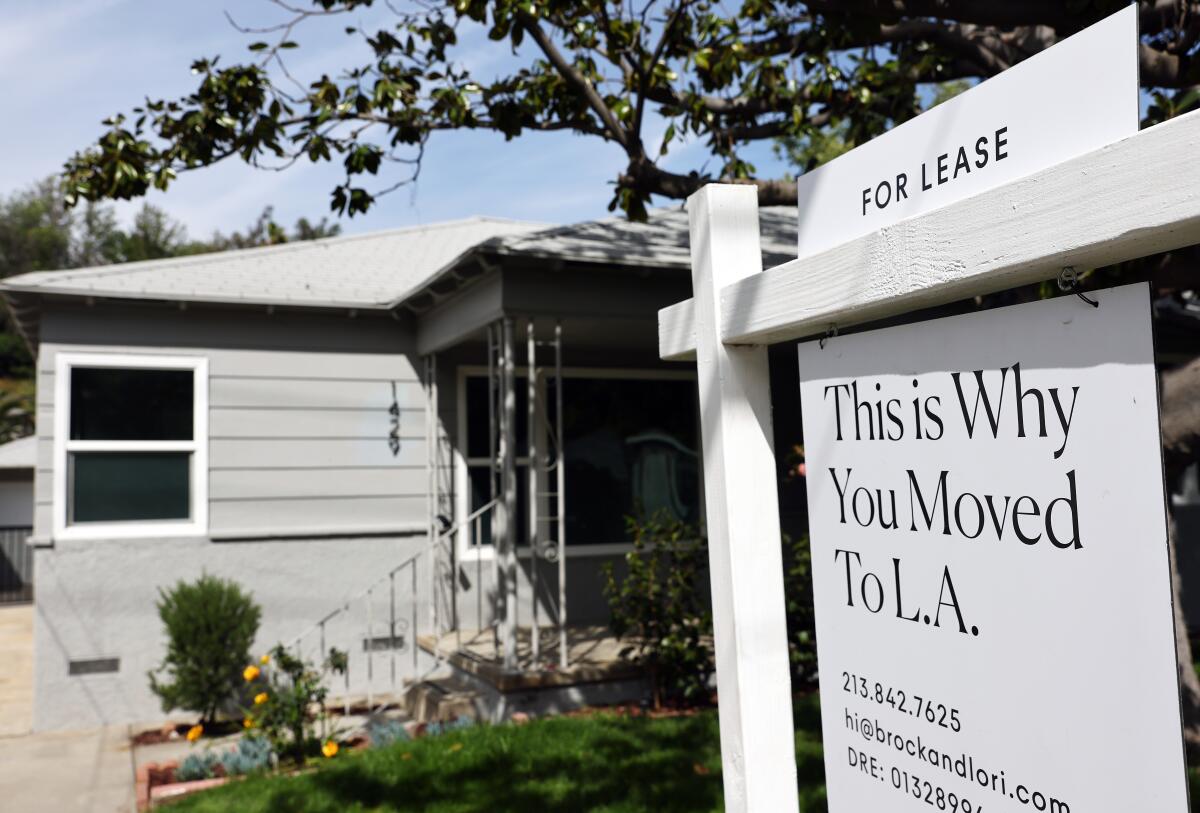Rents are finally falling — but not in Orange County. People are feeling the pain

- Share via
While rents in Los Angeles and many other parts of the U.S. have dropped or stabilized in recent years, Orange County tenants have seen no such relief, with rents that have either spiked or held firm since the start of the pandemic.
The changes reflect a national trend, according to experts. Demand for housing in urban centers including Los Angeles dropped as people flocked to suburbs such as Orange County’s after the pandemic struck because many office staffers were allowed to work remotely.
Los Angeles County cities including Burbank, Long Beach, L.A., Santa Monica and West Hollywood have recorded median rent prices that are 3% to 5% lower than they were this time last year, according to data from the rental site ApartmentList.com.
But prices are moving in the opposite direction in Orange County. Overall rents in L.A. County are down 2.6% over last year, while Orange County prices are up 2.2%, according to Apartment List.
As rents in the U.S. are down 1% overall from last year, “denser urban areas have seen much slower rent growth,” and rentals in outlying and suburban areas have “sustained a pretty strong upwelling of demand” since the COVID-19 pandemic began, said Rob Warnock, a researcher at Apartment List.
But since the pandemic started, rents have fluctuated in L.A. County, dropping 7% in 2020 only to rebound 15% in 2021, and then rising modestly in 2022 before dropping in 2023.
In Orange County, prices never dropped — not even in 2020, though they remained flat. In 2021, they skyrocketed 22% before leveling out in 2022 and increasing modestly in 2023, according to Apartment List.
María Alejandra Barboza, a community tenant counselor in Anaheim and Santa Ana, said that her friends and neighbors are being squeezed by the increases.
Barboza, 56, sees rents continuing to dominate people’s budgets as salaries fail to keep up.
In Anaheim, the median rent for a one-bedroom unit was nearly $2,000 in February, according to data from Apartment List. That was up 1.2% from the same month last year.
In Santa Ana, rents were comparable, and up 1.6% over a year ago.
When Barboza recently visited a friend’s home, she was impressed by new kitchen cabinets. Her friend explained that the cabinets were part of a renovation triggered by the sale of her building.
The new owner made the family move out for a month while continuing to pay rent, according to Barboza.
“They were not given any compensation,” she said. Upon returning after a month away, the family found their rent had increased from $1,460 to $3,200 — more than doubling.
She heard similar stories from others who had already been forced out of the building by higher rents.
“We continually see the displacement of entire families,” Barboza said, adding that stories of housing loss are a constant in her community.
Explore the latest prices for homes and rentals in and around Los Angeles.
California has always had high demand for housing in major cities, said Hanna Grichanik, a financial advisor in Los Angeles.
Her clients are seeing rent increases slow down, though not disappear entirely, she said.
“L.A.’s always been a very inflated market, and it could be that other places are catching up” as density increases elsewhere, she theorized.
Santa Clarita is a notable outlier in Los Angeles County, with the median one-bedroom apartment renting for just over $2,000 and prices up almost 4% over last February.
Grichanik tells her clients that there is “room to negotiate with your landlords,” who “don’t want to have turnover — that’s costly for them.”
She acknowledges that the typical goal of allocating 30% of income to rent “probably works in Nebraska, New Mexico, but it’s very hard for people in California.”
Back in Orange County, advocates seek to protect tenants however they can as prices go up.
David Levy, a housing specialist at the Fair Housing Council of Orange County, praised California’s Tenant Protection Act of 2019, which requires just cause to terminate a rental agreement. Causes include failure to pay, breach of terms, nuisances and criminal activities. The law also caps rent increases for certain tenants at 10%, or at 5% above the annual change in cost of living, whichever is lower.
But Levy believes lawmakers can do more to protect tenants.
Santa Ana is the only city in Orange County with its own rent-control law, he said, so most cities rely on the statewide rules.
Since the end of August, landlords in Los Angeles and Orange counties have been capped at 8.8% rent increases annually in applicable units.
While he appreciates the cap, “even an 8.8% increase is a hard hit for some people,” Levy said.
Barboza, the community tenant counselor, continues to press legislators for a solution and to help those around her.
“Many people in the community do not know what their rights are and how to defend them, in the face of frequent abuse,” she said.
Barboza has heard countless stories of lives disrupted by the lack of affordable housing in Orange County.
When rent gets too high for them, she said, people are not only forced to leave their homes, but “children have to leave their schools” and “parents are separated from their source of income.”
In Barboza’s community, she said, “the greed of a few negatively impacts the lives of many.”
More to Read
Sign up for Essential California
The most important California stories and recommendations in your inbox every morning.
You may occasionally receive promotional content from the Los Angeles Times.












